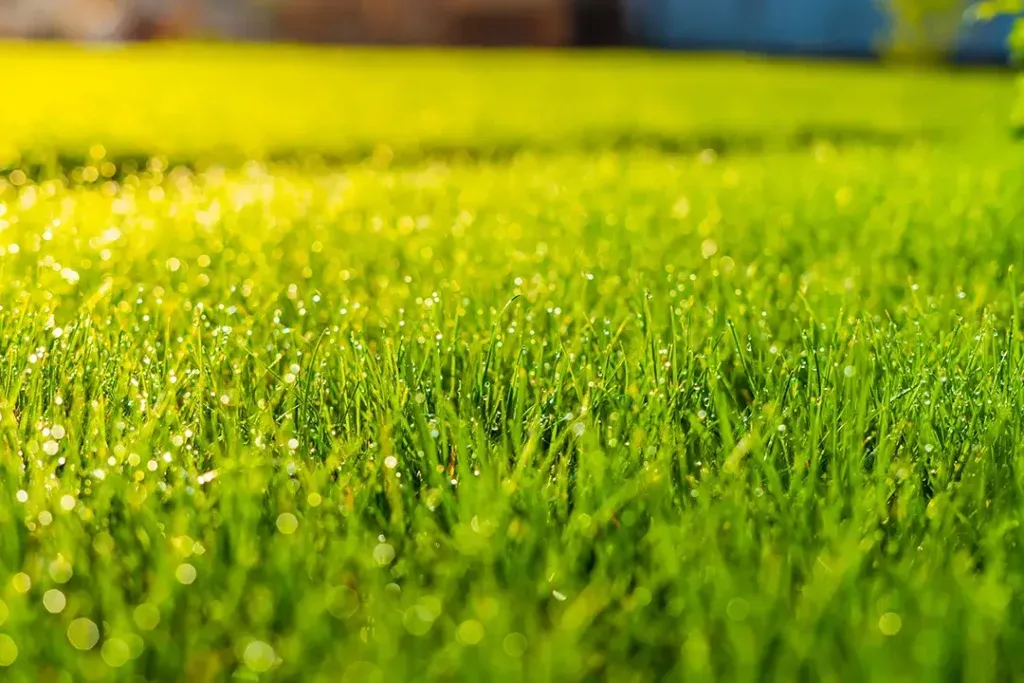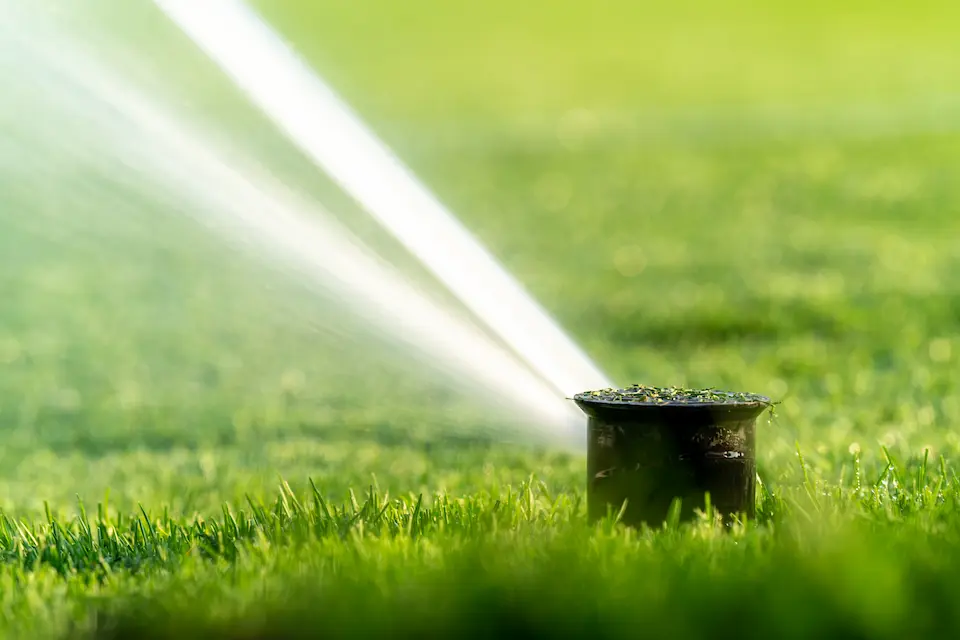
Your watering routine can play a critical role in whether you have a lush, green landscape, or a brown, burned-out lawn. Knowing the best time to water your grass is one of the key components of keeping a healthy lawn.
If you’re looking for a greener lawn, we have several good watering practices you’ll want to follow. From when to water your lawn to factors to consider, the lawn care team at FortSmith Landscaping has you covered so that you know all of the proper watering tips!
Lawn Watering Tips – When Is the Best Time to Water Your Lawn?
Timing is everything when it comes to watering your grass. When you don’t know the right time to water grass, you’re putting your entire landscape at risk. Watering at the wrong time can not only lead to wasteful evaporation but can also increase the chance of lawn diseases. You want to water your grass at the right time so that the grass effectively absorbs the water.
Early Morning
The best time to water your grass is in the early morning, before 10 am. The temperature is cooler, there is less evaporation, and the wind is usually lighter.
When you water your grass in the early morning, the water has time to soak into the soil and reach the grass before the day’s warm sun arrives.
Watering your lawn during this time also prevents the growth of fungus and other diseases. If you water your grass at night, the water sits on the grass blades and can lead to fungus and other diseases.
Late Afternoon/Early Evening
The next best time to water your lawn is during the late afternoon or early evening, after 4 p.m. During this time, the temperature is cooler, and the sun is not as intense. this means there will be less evaporation.
You should avoid watering your grass between 10 am and 4 pm. This is the hottest part of the day. Because the sun is at its strongest, the water will most likely evaporate before it can soak into the soil. This can lead to water waste and damage your grass.
What are the signs grass needs watering?
You can perform a simple test to determine whether your lawn needs watering. Step on it and if it’s flat, it’s time to water. If it springs back, it doesn’t need water yet.
You can also use a rain gauge or moisture meter to measure the amount of water the lawn is receiving. This can help to make sure that the lawn is getting the right amount of water without wasting it or damaging the lawn.
Your lawn’s watering needs can vary depending on the season. When it’s hot and dry, your water may need more frequent watering so it doesn’t dry out. During cooler and wetter weather, you may need to water less to avoid over-saturating your lawn.
Factors to Consider When Watering Your Lawn
When you want a healthy lawn, there are several factors to consider as you water it:
Climate
In hot weather and dry climates, you may need to water your lawn more frequently than in areas with cooler temperatures and wetter climates. Adjust your watering routing according to the weather so that you’re not overwatering it.
Soil Type
Sandy soils tend to drain quickly and may need more water. Clay soil retains water and may require less frequent watering. Doing a soil test can help you determine what type of soil you have. It will also give you the nutrient levels and pH balance so you can create an effective watering schedule.
Grass Type
Cool-season grasses like tall fescue have a deep root system and can tolerate dry conditions. Lawns that are a mixture of Kentucky bluegrass, perennial ryegrass, and fine fescues will go dormant during dry spells if they are not watered but will revive when rain returns.
Warm-season grasses like Zoysia, St. Augustine, Bermuda, and centipede grasses have deep root systems, making them better able to withstand drought. Warm-season grasses typically require less water than cool-season grasses.
How Much Water to Use
Many people are unsure how much water they should be using on their lawns. On an established lawn, it’s recommended to water your grass until the top 6-8 inches of soil is wet.
Most lawns need 1-1.5 inches of water weekly to soak the soil deeply. This can come from rain or watering. You can divide the amount of water during two waterings or do it all at once.
Different Watering Methods
There are a few methods when it comes to watering your lawn.
In-ground sprinklers
These produce the most efficient pattern. If you choose sprinklers that are low to the ground and use a horizontal pattern, you will get the best results.
Pulsating sprinklers
Pulsating sprinklers shoot water horizontally at a high velocity so the wind doesn’t affect the water.
Hose-end sprinklers
These work great for small or medium-sized lawns. Since there are different types, you’ll want to choose the one that best fits your lawn.
Smart watering systems
Use your smartphone and real-time weather data to automate when to water grass so you don’t have to worry about it. There are many different types of smart watering systems, but most integrate with in-ground sprinkler systems.

How to Tell You’ve Watered Your Grass Enough
Check the Soil
To tell if you’ve watered your grass enough, check the soil every 15 minutes by using a screwdriver to see how deep the water has moved. Mark the time once the soil has been soaked to about 6 inches deep. This is how long you should be watering your lawn. If you can’t easily stick the screwdriver into the soil 6 inches deep, you need to add more water.
Use a Flow Timer
Use a water timer that measures water flow in hundreds of gallons. Multiply your lawn’s square footage by 0.62 gallons to determine how much water is needed for the entire lawn.
Do the Math
If you have a sprinkler system, look at the flow rate the manufacturer supplies. Multiply the square footage of your lawn by 0.62 gallons. Divide this number by the sprinkler flow rate. This will let you know how many minutes to run your sprinkler system.
FAQ
Will watering dead grass bring it back?
If your grass is dead, watering it will not bring it back. Watering dormant grass will bring it back. Grass becomes dormant in poor conditions to protect itself.
Does watering grass in the sun cause it to burn?
Watering grass in the sun will not burn it. But remember, it’s not wise to water grass during the time of day when the sun is the strongest.
What’s the best time to water grass seed?
You should water newly planted grass seed twice a day to help it take root, once in the morning and once in the afternoon after the hottest part of the day has passed. Grass seeds need constant moisture and tend to grow best in temperatures between 59- and 69 degrees Fahrenheit.
Can You Overwater Grass?
Yes, you can overwater grass. If you overwater your grass, it can promote fungal growth and disease. It also deprives the grass of the oxygen it needs to live.
If you’re watering a newly seeded lawn, keep the top inch of the soil moist, but not soggy.
Are You Looking for Help in Keeping Your Lawn Plush and Green?
At FortSmith Landscaping, we are committed to helping people in North Carolina have a green lawn they can be proud of. You can count on us for lawn care and landscaping services. Whether you want to set up a lawn care schedule or are looking for a lawn renovation, we can take care of it all.
Call us today at [phone] or reach out online to learn more about our professional landscaping services.
